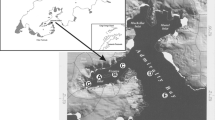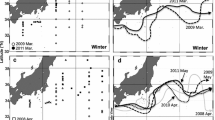Abstract
Pigment composition and size distribution of phytoplankton were analysed in a group of Mediterranean salt marshes, where hydrology is dominated by sudden inputs during sea storms, followed by long periods of confinement. These marshes are characterized by a low inorganic–organic nutrient ratio, and inorganic nitrogen is especially scarce due to denitrification. Nutrients were the main factor affecting phytoplankton biomass, while zooplankton grazing did not control either phytoplankton community composition, or their size distribution. The relative abundance of the different phytoplankton groups was analysed by correspondence analysis using the pigment composition measured by high-performance liquid chromatography (HPLC) and analysed with the CHEMTAX programme. In this analysis, phytoplankton pigment composition was correlated with two nutrient gradients. The first gradient was the ratio of nitrate–total nitrogen (TN), since the different phytoplankton groups were distributed according to their eco–physiological differences in nitrogen uptake. The second gradient was correlated with total nutrient loading. Biomass size distributions frequently showed a lack of intermediate sized nanophytoplankton (2.5–4 μm in diameter), and the importance of this lack of intermediate sizes correlated with dinoflagellate biomass. These results suggested that in confined environments, where nutrients are mainly in an organic form, dinoflagellates take advantage of their mixotrophy, by competing and grazing on smaller phytoplankters simultaneously.






Similar content being viewed by others
References
Armstrong RA (2003) A hybrid spectral representation of phytoplankton growth and zooplankton response: the “control rod” model of plankton interaction. Deep Sea Res (II Top Stud Oceanogr) 50:2895–2916
Badosa A, Boix D, Brucet S, Lopez-Flores R, Quintana XD (2006) Nutrients and zooplankton composition and dynamics in relation to the hydrological pattern in a confined Mediterranean salt marsh (NE Iberian Peninsula). Estuar Coast Shelf Sci 66:513–522
Bavestrello G, Arillo A, Calcinai B, Cattaneo-Vietti R, Cerrano C, Gaino E, Penna A, Sarà M (2000) Parasitic diatoms inside antartic sponges. Biol Bull 198:29–33
Boix D (2000) Estructura i dinàmica de la comunitat animal aquàtica de l’estanyol temporani d’Espolla. Doctorate Thesis. Universitat de Girona, p 663
Britton RH, Crivelli AJ (1993) Wetlands of southern Europe and North Africa: Mediterranean wetlands. In: Whigman DF, Dykyjová D, Hejný S (eds) Wetlands of the world I: inventory, ecology and management. Kluwer, The Netherlands, pp 129–194
Brucet S, Quintana XD, Moreno-Amich R, Boix D (2005) Changes in the shape of zooplankton biomass-size spectra at ecological scaling in a fluctuanting ecosystem (Empordà Wetlands, NE Spain). Vie Milieu 55:31–40
Capblancq J (1990) Nutrient dynamics and pelagic food web interactions in oligotrophic and eutrophic environments: an overview. Hydrobiologia 207:1–14
Cerón García MC, Fernández Sevilla JM, Ancién Fernández FG, Molina Grima E, García Camacho F (2000) Mixotrophic growth of Phaeodactylum tricornutum on glycerol: growth rate and fatty acid profile. J Appl Phycol 12:239–248
Chisholm SW (1992) Phytoplankton size. In: Falkowski PG, Woodhead AD (eds) Primary productivity and biochemical cycles in the sea. Plenum, New York, pp 213–237
Comín FA, Valiela I (1993) On the controls of phytoplankton abundance and production in coastal lagoons. J Coast Res 9:895–906
Cruz-Pizarro L, Carrillo P (1991) Top-down regulation under different species-specific and size-structure grazer assemblages in an oligotrophic lake. In: Giussani G, Van Liere L, Moss B (eds) Ecosystem research in freshwater environment recovery. Pallanza, pp 23–37
Dickie LM, Kerr SR, Boudreau PR (1987) Size-dependent processes underlying regularities in ecosystem structure. Ecol Monogr 57:233–250
Dumont HJ, Van de Velde I, Dumont S (1975) The dry weight estimate of biomass in a selection of Cladocera, Copepoda and Rotifera from plankton, periphyton and benthos of continental waters. Oecologia 19:75–97
Fathi AA, Abdelzaher HMA, Flower RJ, Ramdani M, Kraïem MM (2001) Phytoplankton communities of North African wetlands lakes: the CASSARINA Project. Aquat Ecol 35:303–318
Franks PJS (2001) Phytoplankton blooms in a fluctuating environment: the roles of plankton response time scales and grazing. J Plankton Res 23:1433–1441
Gasiunaite ZR, Olenina I (1998) Zooplankton-phytoplankton interactions: a possible explanation of the seasonal succession in the Kursiu Marios lagoon. Hydrobiologia 363:333–339
Gasol JM, Del Giorgio PA (2000) Using flow cytometry for counting natural planktonic bacteria and understanding the structure of planktonic bacterial communities. Sci Mar (Barc) 64:197–224
Golterman HL (1999) Quantification of P-flux through shallow, agricultural and natural waters as found in wetlands of the Camargue (S-France). Hydrobiologia 392:29–39
Golterman HL (2000) Denitrification and a numerical modelling approach for shallow waters. Hydrobiologia 431:93–104
Granéli E, Turner JT (2002) Top-down regulation in ctenophore-copepod-ciliate-diatom-phytoflagellate communities in coastal waters: a mesocosm study. Mar Ecol Prog Ser 239:57–68
Granéli E, Carlsson P, Legrand C (1999) The role of C, N and P in dissolved and particulate organic matter as a nutrient source for phytoplankton growth, including toxic species. Aquat Ecol 33:17–27
Grasshoff K, Ehrhardt M, Kremling K (1983) Methods of seawater analysis. Verlag Chimie, Weiheim
Guelorget O, Perthuisot J-P, Lamy N, Lefebvre A (1994) Structure et organisation de l’étang de Thau d’après la faune benthique (macrofaune, méiofaune). Relations avec le confinement. Oceanol Acta 17:105–114
Harrison WG, Wood LE (1988) Inorganic nitrogen uptake by marine picoplankton: Evidence for size partitioning. Limnol Oceanogr 33:468–475
Hillebrand H, Dürselen C-D, Kirschtel D, Pollingher U, Zohary T (1999) Biovolume calculation for pelagic and benthic microalgae. J Phycol 35:403–424
Isaksson A (1998) Phagotrophic phytoflagellates in lakes—a literature review. Arch Hydrobiol Spec Issues Advanc Limnol 51:63–90
Ismael AA (2003) Succession of heterotrophic and mixotrophic dinoflagellates as well as autotrophic microplankton in the harbour of Alexandria, Egypt. J Plankton Res 25:193–202
Jones RI (2000) Mixotrophy in planktonic protists: an overview. Freshw Biol 45:219–226
Li A, Stoecker DK, Coats DW, Adam EJ (1996) Ingestion of fluorescently labeled and phycoerythrin-containing prey by mixotrophic dinoflagellates. Aquat Microb Ecol 10:139–147
Li A, Stoecker DK, Coats DW (2001) Use of the “food vacuole content” method to estimate grazing by the mixotrophic dinoflagellate Gyrodinium galatheanum on cryptophytes. J Plankton Res 23:303–318
Lohrenz SE, Carroll CL, Weidemann AD, Tuel M (2003) Variations in phytoplankton pigments, size structure and community composition related to wind forcing and water mass properties on the North Carolina inner shelf. Cont Shelf Res 23:1447–1464
López-Flores R, Garcés E, Boix D, Badosa A, Brucet S, Masó M, Quintana XD (2006) Comparative composition and dynamics of harmful dinoflagellates in Mediterranean salt marshes and nearby external marine waters. Harmful Algae (in press)
Mackey MD, Mackey DJ, Higgins HW, Wright SW (1996) CHEMTAX-A program for estimating class abundances from chemical markers: application to HPLC measurements of phytoplankton. Mar Ecol Prog Ser 144:265–283
Malley DF, Lawrence SG, Maclver MA, Findlay WJ (1989) Range of variation in estimates of dry weight for planktonic crustacea and rotifera from temperate north American lakes. Can Tech Rep Fish Aquat Sci 1666:0–49
Malone TC (1980) Algal size and phytoplankton ecology. In: Morris I (ed) Physiological ecology of phytoplankton. Blackwell, Oxford, pp 433–463
Moss B, McGowan S, Carvalho L (1994) Determination of phytoplankton crops by top-down and bottom-up mechanism in a group of English lakes, the West Midlands meres. Limnol Oceanogr 39:1020–1029
Muylaert K, Declerck S, Geenens V, Van Wichelen J, Degans H, Vandekerkhove J, Van der Gucht K, Vloemans N, Rommens W, Rejas D, Urrutia R, Sabbe K, Gillis M, Decleer K, De Meester L, Vyverman W (2003) Zooplankton, phytoplankton and the microbial food web in two turbid and two clearwater shallow lakes in Belgium. Aquat Ecol 37:137–150
Olson RJ, Vaulot D, Chisholm SW (1985) Marine phytoplankton distributions measured using shipboard flow cytometry. Deep-Sea Res 32:1273–1280
Olson RJ, Zettler ER, Anderson OK (1989) Discrimination of eukaryotic phytoplankton cell types from light scatter and autofluorescence properties measured by flow cytometry. Cytometry 10:636–643
Ortega-Mayagoitia E, Rojo C, Rodrigo MA (2003) Controlling factors of phytoplankton assemblages in wetlands: an experimental approach. Hydrobiologia 502:177–186
Perez-Ruzafa A, Diego CM (1993) La teoría del confinamiento como modelo para explicar la estructura y zonación horizontal de las comunidades bentónicas en las lagunas costeras. Publ Espec Inst Esp Oceanogr 11:347–358
Pérez-Ruzafa A, Gilabert J, Gutiérrez JM, Fernández AI, Marcos C (2002) Evidence of a planktonic food web response to changes in nutrient input dynamics in the Mar Menor coastal lagoon, Spain. Hydrobiologia 475–476:359–369
Quintana XD, Moreno-Amich R, Comín FA (1998) Nutrient and plankton dynamics in a Mediterranean salt marsh dominated by incidents of flooding. Part I. Differential confinement of nutrients. J Plankton Res 20:2089–2107
Quintana XD, Badosa A, Gesti J (2001) LIFE Project. Restoration and regulation of the lagoons and coastal systems of the Lower Ter. 8-11-2004. On line. http://www.torroella.org/life
Rodríguez J, Jiménez-Gómez F, Blanco JM, Figueroa FL (2002) Physical gradients and spatial variability of the size structure and composition of phytoplankton in the Gerlache Strait (Antarctica). Deep Sea Res (II Top Stud Oceanogr) 49:693–706
Ruttner-Kolisko A (1977) Suggestions for biomass calculations of plankton rotifers. Arch Hydrobiol–Beih Ergebn Limnol 8:71–76
Schönborn W (1992) Comparative studies on the production Biology of protozona communities in freshwater and soil ecosystems. Arch Protistenkd 141:187–214
Serrano L, Burgos MD, Díaz-Espejo A, Toja J (1999) Phosphorus inputs to wetlands following storm events after drought. Wetlands 19:318–326
Smock LA (1980) Relationships between body size and biomass of aquatic insects. Freshw Biol 10:375–383
Sommer U, Sommer F, Santer B, Jamieson C, Boersma M, Becker C, Hansen T (2001) Complementary impact of copepods and cladocerans on phytoplankton. Ecol Lett 4:550
Sprules WG, Goyke AP (1994) Size-based structure and production in the pelagia of lakes Ontario and Michigan. Can J Fish Aquat Sci 51:2603–2611
Sprules WG, Stockwell JD (1994) Size-based biomass and production models in the St Lawrence Great Lakes. ICES J Mar Sci 52:705–710
Stal LJ (2000) Cyanobacterial mats and stromatolites. The ecology of cyanobacteria. Their diversity in time and space. Kluwer, The Netherlands, pp 62–108
Stoecker DK (1999) Mixotrophy among dinoflagellates. Eukaryot Microbiol 46:397–401
Stoecker DK, Li A, Coats DW, Gustafson DE, Nannen MK (1997) Mixotrophy in the dinoflagellate Prorocentrum minimum. Mar Ecol Prog Ser 152:1–12
Thingstad TF, Havskum H, Garde K, Riemann B (1996) On the strategy of “eating your competitor”: a mathematical analysis of algal mixotrophy. Ecology 77:2108–2118
Throndsen J (1995) Estimating cell numbers. In: Hallegraeff GM, Anderson DM, Cembella AD (eds) Manual on harmful marine microalgae. UNESCO, Paris, pp 63–80
Utermöhl H (1931) Über das umgekehrte Mikroskop. Arch Hydrobiol 22:643–645
Vanni MJ, Layne CD, Arnott SE (1997) “Top-down” trophic interactions in lakes: effects of fish on nutrients dynamics. Ecology 78:1–20
Vidondo B, Prairie YT, Blanco JM, Duarte CM (1997) Some aspects of the analysis of the size spectra in aquatic ecology. Limnol Oceanogr 42:184–192
Wen Z-Y, Chen F (2003) Heterotrophic production of eicosapentaenoic acid by microalgae. Biotechnol Adv 21:273–294
Winiwarter P, Cempel C (1992) Life symptoms: the behaviour of open systems with limited energy dissipation capacity and evolution. Syst Res 9:9–34
Yentsch CS, Phinney DA (1984) Observed changes in spectral signatures of natural phytoplankton population: the influence of nutrients availability. In: Holm-Hansen O, Bolis L, Gilles R (eds) Physiological ecology of phytoplankton. Springer, Berlin Heidelberg New York, pp 95–128
Zapata M, Garrido JL (1991) Influence of injection conditions in reversed-phase high-performance liquid chromatography of chlorophylls and carotenoids. Chromatographia 31:589–594
Zapata M, Rodriguez F, Garrido JL (2000) Separation of chlorophylls and carotenoids from marine phytoplankton: a new HPLC method using a reversed phase C8 column and pyridine-containing mobile phases. Mar Ecol Prog Ser 195:29–45
Acknowledgements
This work was supported by a grant from the Comisión de Investigación Científica y Técnica (CICYT), Programa de Recursos Naturales (ref. CGL2004-05433 / BOS) and by a BR grant of the University of Girona. Anonymous reviewers are thanked for their comments that led to the final manuscript.
Author information
Authors and Affiliations
Corresponding author
Additional information
Communicated by S.A. Poulet, Roscoff
Rights and permissions
About this article
Cite this article
López-Flores, R., Boix, D., Badosa, A. et al. Pigment composition and size distribution of phytoplankton in a confined Mediterranean salt marsh ecosystem. Mar Biol 149, 1313–1324 (2006). https://doi.org/10.1007/s00227-006-0273-9
Received:
Accepted:
Published:
Issue Date:
DOI: https://doi.org/10.1007/s00227-006-0273-9




